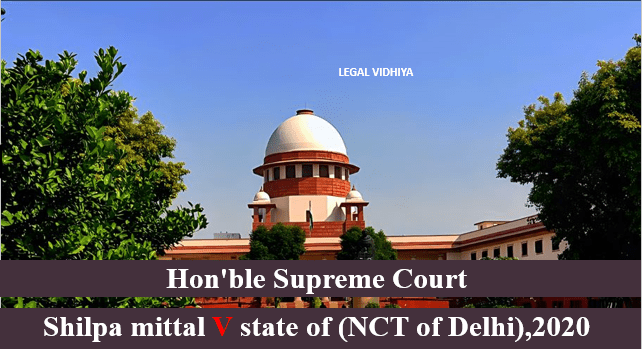
Citation -AIR 2020 SC 405
Date of judgement -9 January,2020
Court- Supreme court of india
Case Type -Criminal law
Appellant -Shilpa Mittal
Respondent -State of NCT of delhi
Bench- Deepak Singh Gupta and Aniruddha Bose
FACTS OF THE CASE
An offence punishable under Section 304 of IPC,1860 was alleged to be committed by a juvenile (above 16 but below 18),which gives a maximum punishment of up to 10 years and a fine with no minimum sentence prescribed.
The appeal filed in Delhi High court against the decision of the Juvenile Justice Board that held the Juvenile to be tried as an adult for committing the heinous offence was overturned and held that juvenile is not liable under ‘heinous offence ‘ since no minimum sentence was prescribed and hence did not fall within the ambit of Section 2(33) of the Juvenile Justice Act. Against the decision of the Delhi High Court,the appellant filed an appeal before Hon’ble Supreme Court.
ISSUES
1. Whether Section 2(33) of juvenile Justice Act,2015 extends to those offences prescribing either no minimum punishment or a minimum punishment of less than 7 years but states clearly the maximum punishment of more than 7 years.
2. How can a juvenile be treated under a category of an offence that is not defined in the statute but that the appellant argues should be included as an offence?
CONTENTIONS
–APPELLANT
The counsel of the appellant claimed that the legislature failed to recognised the ‘fourth category ‘ of offences,as addressed in the issue,as falling within the ambit of ‘heinous offence ‘as defined by Section 2(33).As a result,the counsel submitted his contention to the court that if the word ‘ minimum’ is eliminated from the definition of ‘heinous crimes’ provide under Section 2 (33) by the effect of the doctrine of surplusage(non-necessary) then all offences except for the petty and serious would naturally fall under the heading of ‘ heinous offences’
–RESPONDENT
The counsel for the respondent contended in response to the Appellant’s submission before the court by reminding the court’s limitation to rewrite a law only on the basis of an existing lacuna in
the Act ,and that the statue could only be corrected by the legislature itself.Furthermore,the counsel argued that the legislature intent cannot be determined solely by the absence of cognizance of a certain category of offences under the Act in question.
JUDGEMENT
The court concluded that the legislature’s aim behind the Act was to keep the statue in the best interest of the child by designing a detailed procedure to be followed before the kid was tried as an adult,based on Section 2(33) read in conjunction with Section 14,15 and 19 of the Act. Thus,the Hon’ble Supreme court held that offences with a minimum sentences of 7 years but a maximum sentence of more than 7 years cannot be considered ‘heinous offence ‘,but instead fall under the scope of ‘serious offences’ ,as defined by the Act ,and will be deleted until parliament takes action on the issue .
REFERENCE
-Https://Indiakanoon.org.
-SCC online
-Live law
Disclaimer: The materials provided herein are intended solely for informational purposes. Accessing or using the site or the materials does not establish an attorney-client relationship. The information presented on this site is not to be construed as legal or professional advice, and it should not be relied upon for such purposes or used as a substitute for advice from a licensed attorney in your state. Additionally, the viewpoint presented by the author is of a personal nature.




0 Comments